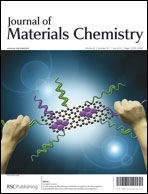Fabrication of nanostructured W–Y2O3 materials by chemical methods†
Abstract
A novel method for the fabrication of highly uniform oxide dispersion-strengthened (ODS) materials made by chemical processing is presented. The powders are fabricated by a two-step route starting with a chemical synthesis at room temperature, producing nanocrystalline yttrium doped tungsten trioxide hydrate precursor powders. Thermogravimetric analysis with evolved gas analysis revealed the presence of ammonium nitrate in the precursors. The second step is the reduction of the precursor in a hydrogen atmosphere at 600 and 800 °C. The reduced powders, containing W-1.2%Y2O3, showed two types of tungsten particles, cube-shaped with a size less than 250 nm and finer particles (<50 nm) of both spherical and cubic shape. The powder was consolidated by spark plasma sintering at 1100 °C, producing a bulk material with a relative density of 88%. Characterization of the sintered materials by high resolution scanning electron microscopy revealed a uniform microstructure with tungsten grains of less than 300 nm and nanosized oxide particles uniformly dispersed at the tungsten grain boundaries, as well as inside the tungsten grains. Experimental determination of the elastic properties was conducted by nanoindentation tests and fracture toughness was studied by radial indentation cracking.


 Please wait while we load your content...
Please wait while we load your content...